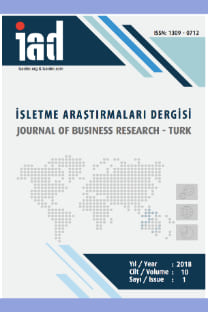Mutual Switching Behavior between High Growth and Low Growth Economies’ Stock Markets
___
Ang, A., Timmermann, A., (2011). “Regime Changes and Financial Markets”, NBER Working, Paper No. 17182Arestis, P., Demetriades, P. O., Luintel, K. B. (2001). “Financial Development and Economic Growth: The Role of Stock Markets”, Journal of Money, Credit and Banking, Vol. 33, No. 1, 16-41.
Balcilar, M., Ozdemir, Z. A. (2013). “Asymmetric and Time-Varying Causality between Inflation and Inflation Uncertainity in G-7 Countries” Scottish Journal of Political Economy Vol. 60, No. 1, 1-42.
Balcilar, M., Gupta, R., Wohar, M.E. (2015) “Common Cycles and Common Trends in the Stock and Oil markets: Evidence from More than 150 Years of Data”, Department of Economics Working Paper Series, 2015-72.
Beck, T., Levine, R. (2004). “Stock markets, banks, and growth: Panel evidence”, Journal of Banking & Finance, Vol. 28, No. 3, 423-442.
Bildirici, M., E., Aykaç Alp, E., Ersin, Ö. Ö., Bozoklu, Ü. (2010). İktisatta Kullanılan Doğrusal Olmayan Zaman Serisi Yöntemleri, İstanbul: Türkmen Kitabevi.
Çevik, E. İ., Korkmaz, T., Atukeren, E. (2012). “Business confidence and stock returns in the USA: a time-varying Markov regime-switching model”,Applied Financial Economics, No. 22, 299–312
Dorina, L., Simina, U., (2006). “Testing Efficiency of the Stock Market in Emerging Economies”, The Journal of the Faculty of Economics-Economic Science Series, No. 2, 827-831.
Gozbasi, O. (2015). “Interaction between stock market development and economic growth: Evidence from developing countries”, Eskisehir Osmangazi University Journal of Economics and Administrative Sciences, Vol. 10, No. 2,: 269-284.
Guidolin, M., Timmermann. A. (2006) “An econometric model of nonlinear dynamics in the joint distribution of stock and bond returns” Journal of Applied Econometrics Vol. 21, No. 1, 1-22.
Guidolin M. “Modelling, Estimating and Forecasting Financial Data under Regime (Markov) Switching”
http://didattica.unibocconi.it/mypage/dwload.php?nomefile=Lecture_7_- _Markov_Switching_Models20130520235704.pdf, (accessed 30.03.2016).
Gürbüz, A. O. (2004). Dünya’dan ve Türkiye’den Örneklerle Hesaplama Yöntemlerine Göre Hisse Senedi Endeksleri ve Yatırımcı İlgisini Yansıtan Bir Endeks Önerisi. İstanbul: Yaylım Yayıncılık.
Hamilton J. D. (1989). “A New Approach to the Economic Analysis of Nonstationary Time Series and the Business Cycle”, Econometrica, Vol. 57, No. 2, 357-384.
Hamilton J. D., Susmel, R. (1994). “Autoregressive conditional heteroskedasticity and changes in regime”, Journal of Econometrics, Vol.64, No. 1-2, 307-333.
Harrison, B., Moore W., “Nonlinearities in Stock Returns for Some Recent Entrants to The EU”, Discussion Papers in Economics, Nottingham Trent University. No.2010/1.
Kaplan, M. 2008 “The Impact of Stock Market on Real Economic Activity: Evidence from Turkey”, Journal of Applied Sciences, Vol. 8, No. 2:, 374-378.
Kim, S., Kim, S.Y., Choi, K. (2017) “Modeling and analysis for stock return movements along with exchange rates and interest rates in Markov regimeswitching models”, Cluster Computing, https://doi.org/10.1007/s10586-017-1519- 7, In press.
Kolb, R. W., Overdahl., J. D. (2007) Futures, Options and Swaps., Fifth Ed., UK: Blackwell Publishing.
Krolzig H. M. (2000). “Predicting Markov-Switching Vector Autoregressive Processes” Working Paper 2000W31Oxford University.
Lim, K. P., Chee, W. H. (2012) “Non-Linear Predictability in G7 Stock Index Returns”, The Manchester School, Vol. 81, No. 4, 620-637.
Marcucci, J. (2005) “Forecasting Stock Market Volatility with Regime-Switching GARCH Models”, Studies in Nonlinear Dynamics & Econometrics, Vol. 9, No. 4, 1-55.
Nazer, S. B., Samir G. (2007) “Stock markets, banks, and economic growth: Empirical evidence from the MENA region”, Research in International Business and Finance, No. 21, 297-315.
Ngare, E., Nyamongo, E. M., Misati, R. N. (2014). “Stock market development and economic growth in Africa”, Journal of Economics and Business, No.74, 24-39.
Nielsen S., Olesen, J. O. (2000). “Regime-Switching Stock Returns and Mean Reversion” Working paper 11-2000.
Perez-Quiros, G., Timmermann, A. (2001). “Business cycle asymmetries in stock returns: Evidence from higher order moments and conditional densities”, Journal of Econometrics, Vol. 103, No. 1, 259-306.
Rousseau, P. L., Wachtel, P. 2000. “Equity markets and growth: Cross-country evidence on timing and outcomes, 1980-1995”, Journal of Banking & Finance, Vol. 24, No. 12, 1933-1957.
Schaller H., Norden, S. V. (1997). “Regime switching in stock market returns”, Applied Financial Economics, No. 7, 177- 191.
Schwert, G. W. (1989). “Why does stock Market Volatility Change Over Time?”, The Journal of Finance, Vol.44, No.5., 1115-1153.
Seddighi, H. R., Nian, W. (2004). “The Chinese stock exchange market: Operations and efficiency”, Applied Financial Economics, No. 14, 785-797.
Song, W., Ryu, D., Webb, R. I. (2016), “Overseas Market Shocks and VKOSPI Dynamics: A Markov Switching Approach”, Finance Research Letters, Vol.16, 275-282.
Zhu, H., Su, X., You, W., Reni Y. (2016), “Asymmetric effects of oil price shocks on stock returns: evidence from a two-stage Markov regime-switching approach”, Applied Aconomics, Vol. 49, No. 25, 2491-2507.
- ISSN: 1309-0712
- Yayın Aralığı: 4
- Başlangıç: 2009
- Yayıncı: Melih Topaloğlu
Çalışma Arkadaşlarına İlişkin Algıların Örgütsel Vatandaşlık Davranışı ve Sinizme Etkisi
The Relationship between Authentic Leadership and Employees' Virtual Loafing and Cynic Behaviors
HALİL ÖZCAN ÖZDEMİR, HAKAN VAHİT ERKUTLU
NAZMİYE ÜLKÜ PEKKAN, ABDULLAH ÇALIŞKAN
İşbaşı Eğitim Uygulamaları, Öz-Yeterlilik Ve Yenilikçilik Davranışı Arasındaki İlişki
Banking Websites in Turkey: an Accessibility, Usability and Security Evaluation
HASAN EMİN GÜRLER, RAMAZAN ERTURGUT
ÖZGÜR ÇATIKKAŞ, AYHAN YATBAZ, SELİM DURAMAZ
Parasal Sistemde Altının Yeri ve Altına Dayalı Finansal Araçlar
Gültekin RODOPLU, BİLGE LEYLİ ELİTAŞ
How Does Customer Experience Shape the Attitude Towards and Intention to Brand Switching?
EDİN GÜÇLÜ SÖZER, MUSTAFA EMRE CİVELEK
Entropi ve Aras Yöntemleriyle Havayolu İşletmelerinde Hizmet Kalitesinin Değerlendirilmesi
